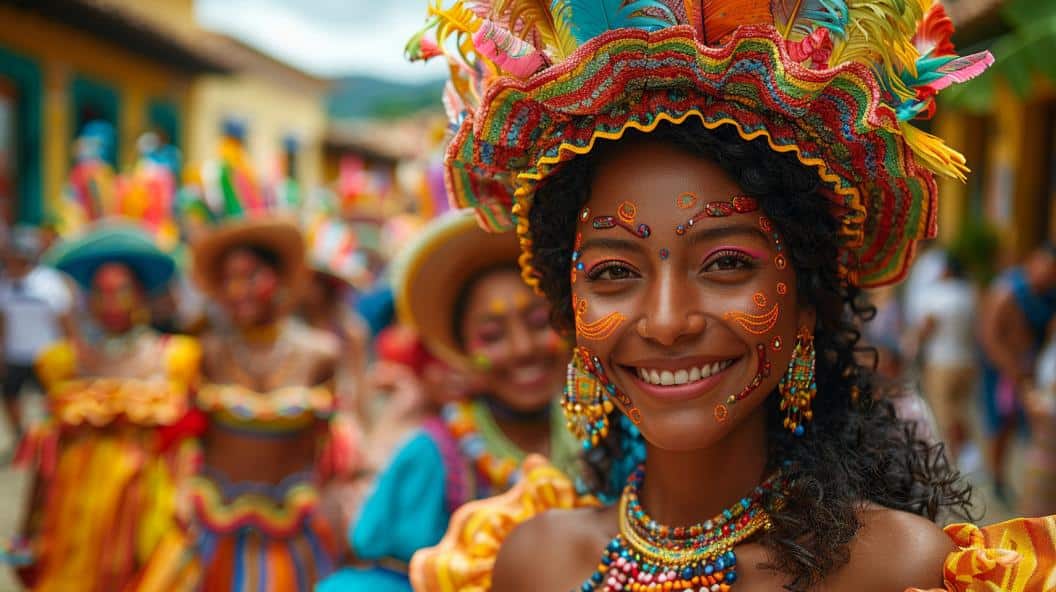Have you ever wondered how wedding rituals vary across the globe or what festivals have marked the history of a people? “Cultures Around the World: Discover Traditions” is an invitation to uncover the religious ceremonies, wedding rituals and traditional festivals that define societies and weave the rich tapestry of humanity. From the sumptuous to the simple, the colorful to the contemplative, each tradition tells a unique story — a singular journey that resonates the essence of each culture. Embark with us on this cultural expedition and be inspired by the diversity that surrounds us.
What are the unique ceremonies and rituals in different cultures?
Ceremonies and rituals are vibrant manifestations of cultural heritage, eternalizing values, beliefs and the identity of a people. In every corner of the world, there are unique traditions that mark significant moments in the life of a community.
Religious ceremonies around the world demonstrate the spiritual diversity of people. An example are the religious festivals and the symbolism behind them, like Diwali in India, which celebrates the victory of light over darkness.
Wedding rituals and customs, such as vivid Indian weddings that last for days, reflect the importance placed on the union of two families, while subtle Japanese ceremonies honor harmony and respect.
Traditional festivals around the world These are celebrations that often follow the rhythm of the seasons and agricultural cycles. For example, Hanami in Japan celebrates the ephemerality of life with the contemplation of cherry blossoms, while Carnival in Brazil is an explosion of music and color before the liturgical period of Lent.
Weddings have their varied traditions around the world, where each culture sees the celebration differently. In India, for example, the event is marked by Haldi, a ritual where a turmeric paste is applied to the bride and groom to bring good luck.
In addition, there are ceremonies for the transition of life stages. Among the Maasai, as recorded on the page Masais on Wikipedia, there is Eunoto, which symbolizes the passage of young warriors into adulthood – an event of great social significance.
Each of these traditions provides a vivid glimpse into the cultures that practice them, and despite modern challenges such as globalization and environmental impact, these ceremonies persist, preserving historical significance and strengthening community bonds. Through their unique rituals, they tell ancestral stories and celebrate the continuity of life and community – crucial aspects that connect us as human beings.
What types of typical dances and music are found globally?
On our journey around the world, cultural traditions manifest themselves in many ways, but few are as vibrant as dance and music. Let's start with the typical international dances. For example, in India, we have the classic Bharatanatyam, which tells stories through gestures and facial expressions. In the heart of Africa, Maasai dance is a demonstration of strength and community. Crossing the ocean, we arrive in Brazil, where samba reigns during Carnival, a spectacle of rhythm and movement that captures the country's energy.
A ethnic music and its origins take us to another dimension of cultural understanding. From the quirky Irish ballad to Australia's Aboriginal didgeridoo, each note is a narrative of its people. In exploring these origins, we come across a broad heritage reflected in the dances, where each step is loaded with historical and social meaning.
Curious about the spiritual roots of these expressions? A ethnic music It's not just entertainment; it offers a deep connection with the divine, whether in the shamanic chants of Siberia or the sacred mantras of Tibet. The melodies create a feeling of unity in the celebrations, while the dance solidifies community identity.
As pointed out in the summary, these cultural elements are vital in the formation of the identity of societies. They not only represent the continuity of ancestral traditions, but also highlight the beauty and individuality of each people. At the same time, they face modern challenges such as declining participation and environmental impacts. Yet they persist: resilient, full of historical significance and community ties.
So, when we travel through the world of traditional dance and music, we don't just watch a spectacle for the senses – we delve deep into the soul of a culture.
How does gastronomy reflect the traditions of a people?
By exploring traditional global cuisine, it is possible to glimpse the soul of a culture, where each ingredient, cooking technique and dish has its own story to tell. The unique elements in the cuisine of different regions are more than just components of a menu; they are symbols of cultural identity, historical moments and the relationship between people and nature and the land where they live.
For example, Japan has a tradition of Hanami, a celebration that dates back to the Nara period and involves the viewing of cherry blossoms. This event reflects the philosophy of ephemeral beauty and appreciation of nature, expressed through the preparation of delicate and aesthetically pleasing dishes that complement the Hanami experience.
In Spain, La Tomatina, which takes place on the last Wednesday of August, attracts thousands of people to Buñol for a memorable tomato battle. The festival highlights entertainment and food, which, although used in unconventional ways, celebrates the abundance of local produce.
India, with its Holi, celebrates the “Festival of Colors” in March, symbolizing the victory of good over evil. The vibrant colors spread in the air are complemented by the exchange of sweets and traditional dishes, which promote unity and share joy among communities.
In East Africa, the Masais conduct the Eunoto ceremony, marking the transition from youth to adulthood. This intricate rite is accompanied by meals that reinforce the importance of the occasion and accentuate the communion between the members of the tribe.
Brazil's Carnival is known for its parades, samba music, elaborate costumes and street parties, showing how gastronomy — with dishes such as feijoada and acarajé — mixes with the rhythm of the celebration and represents a unique cultural fusion.
Despite modern challenges such as declining participation and environmental impacts, these culinary traditions endure and remain essential to preserving historical significance and community bonds. They demonstrate a resilience that delights those in search of authentic experiences and continues the stories of people around the world.
How do traditional games and sports influence a sense of community?
Traditional games and sports act as true social catalysts, intertwining individuals through the sharing of collective experiences and celebrations. Friendly competitions and the act of cheering together strengthen community ties, promoting a sense of belonging and identity. But how precisely do these games influence a sense of community?
The influence of these games on the sense of community is profound. They provide a stage for the expression of cultural identities, honor historical traditions, reinforce solidarity among community members, and often constitute the essence of New Year celebrations and other significant festivals around the world.
In many cultures, for example, the new year is not only marked by the advancement of the calendar, but by the playful activities that occur at this time. Whether playing “Hanetsuki” in Japan, which is similar to badminton, or watching street football games in Brazil, sports serve as a platform for expressing joy and hope for the year to come.
India celebrates Diwali, also known as the Festival of Lights, where in addition to decorative lights, board and card games are traditionally played. This highlights an interesting aspect: often, these traditional games and sports are not merely about competition, but about strengthening interpersonal relationships and imparting moral and social teachings.
Native Mongolian games like Naadam Festival somehow fulfill a similar role. There, wrestling, horse racing and archery competitions not only celebrate physical skills, but also endurance, honor and community spirit.
As we evaluate the importance of these elements, it becomes evident that traditional games and sports are more than just entertainment. They are living pieces of human history, epitomizing community values and serving as points of unity. We are, collectively, playing to keep our traditions alive, nurturing a sense of community, and continuing to weave the rich tapestry of human experience.
How do traditional clothing express cultural identity?
The colors and patterns in traditional clothing are more than mere aesthetics; they carry deep meanings that often reflect the history, environment and values of a society. For example, in the people Maasai From East Africa, each color of beads and fabrics has a specific meaning, such as peace, courage and health, making their clothing a reflection of their beliefs and nature.
But have you ever wondered about the connection between ceremonial clothing and the cultural heritage of humanity? The costume is not just clothing for festive occasions, it symbolizes the transmission of an intangible heritage, evoking respect for the traditions that define the identity of a people.
Let's explore further. In India, the sari, worn by women in many regional variants, is not just clothing but an expression of respect for culture and family roots. In an ordered Japanese society, the kimono symbolizes not only the wearer's social status, but also the appreciation of harmony and the ephemerality of time, ideas that are settings for Hanami.
Ceremonial clothing, therefore, goes beyond its practical function. During Carnival festivities in Brazil, exuberant costumes express the joy and cultural freedom of a people who know how to value the art of celebrating together. Every feather and sequin is a relic of a collective identity proud of its cultural heritage.
Every piece of traditional clothing we know is woven not just with threads, but with stories and meanings that resist time and globalization. They are resilient symbols of a rich human heritage that continues to inspire both locals and those seeking cultural authenticity around the world.
In this article, we delve into the essence of the cultural traditions that permeate our planet – from the ceremonies that mark life transitions to the rhythms and steps that define the typical dances of each people. We also address the unique flavor of cuisine as a reflection of cultural practices, the way games and sports strengthen the community fabric, and the deep symbolism of traditional clothing. Each element is a thread that weaves the rich tapestry of cultural identity. By appreciating these traditions, we come closer to understanding human diversity and the depth of its expressions.
FAQ
FAQ: Unique Ceremonies and Rituals in Different Cultures
What are some examples of notable religious ceremonies around the world?
Notable religious ceremonies include the Diwali festival in India, which celebrates the victory of light over darkness, reflecting the spiritual diversity of cultures around the world.
How do different cultures view and celebrate wedding rituals?
Cultures visualize and celebrate wedding rituals in different ways, as is the case with Indian weddings that last days and are full of colors, representing the union of two families, in contrast to the subtle Japanese ceremonies that prioritize harmony and respect.
How are traditional festivals connected to the cycles of the seasons and agriculture?
Traditional festivals, such as Hanami in Japan and Carnival in Brazil, are often aligned with the seasons and agricultural cycles, representing moments to celebrate seasonal changes and the ephemerality of life through vibrant community rituals.
Are there ceremonies that mark the transition to adulthood in different cultures?
Yes, there are ceremonies that mark the transition to adulthood, such as the Eunoto of the Maasai, which has great social significance as it symbolizes the passage of young warriors into adulthood.
FAQ: Typical Global Dances and Music
What are some typical international dances and their meanings?
Typical dances such as Bharatanatyam in India, Maasai dance in Africa and samba in Brazil are vibrant expressions of cultural identity, telling stories and demonstrating strength and community through gestures, facial expressions and movement.
How does ethnic music relate to cultural and spiritual backgrounds?
Ethnic music is deeply rooted in cultural and spiritual origins, offering a connection to the divine through shamanic chants, sacred mantras and traditional ballads, each reflecting the narrative and spirit of its people.
FAQ: Reflections of Gastronomy on Cultural Traditions
How can gastronomy reflect the traditions and identity of a people?
Gastronomy reflects the traditions and identity of a people through the choice of ingredients, culinary techniques and typical dishes, which symbolize the history, values and relationship of people with the land, as demonstrated by Hanami in Japan, La Tomatina in Spain and the Festival of Colors in India.
How are foods integrated into festivals and ceremonies?
Food is significantly integrated into festivals and ceremonies, whether through the exchange of sweets during Holi in India, or through dishes that mark festivities and celebrate values such as unity and abundance, such as feijoada during Carnival in Brazil.
FAQ: The Influence of Traditional Games and Sports on Community Sense
How important are traditional games and sports for a sense of community?
Traditional games and sports are centrally important to a sense of community, as they promote cultural identity, reinforce social bonds, honor traditions and serve as a focal point for celebrations such as New Year's around the world.
How are games celebrated during significant cultural festivals?
During cultural festivals such as Diwali in India and Naadam in Mongolia, games are celebrated not only as forms of entertainment, but as a means of strengthening social relationships and transmitting community values through friendly competitions and cooperative activities.
FAQ: Expressing Cultural Identity Through Traditional Clothing
How can traditional clothing express the cultural identity of a people?
Traditional clothing expresses cultural identity through colors, patterns and styles that reflect the social, historical and environmental values of a people, such as the Maasai's colorful beads that symbolize peace and courage.
To what extent does ceremonial dress contribute to the preservation of cultural heritage?
Ceremonial attire is a tangible expression of intangible cultural heritage, the use of which on festive occasions symbolizes and preserves cultural heritage, identity and respect for traditions, as in the examples of the sari in India and the kimono in Japan.







